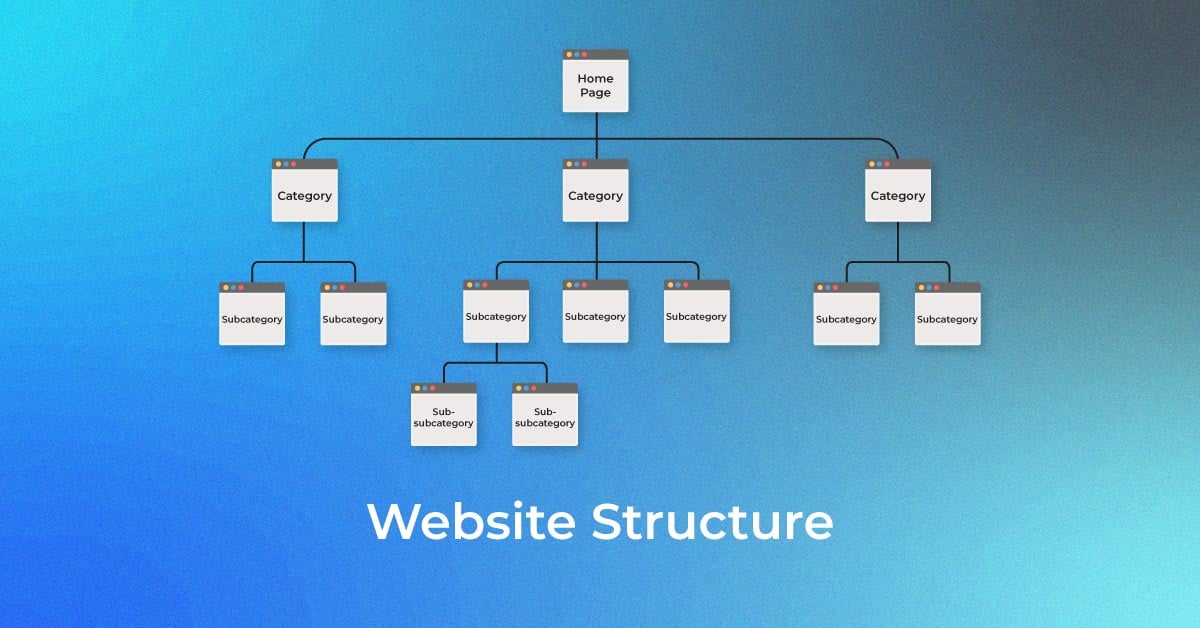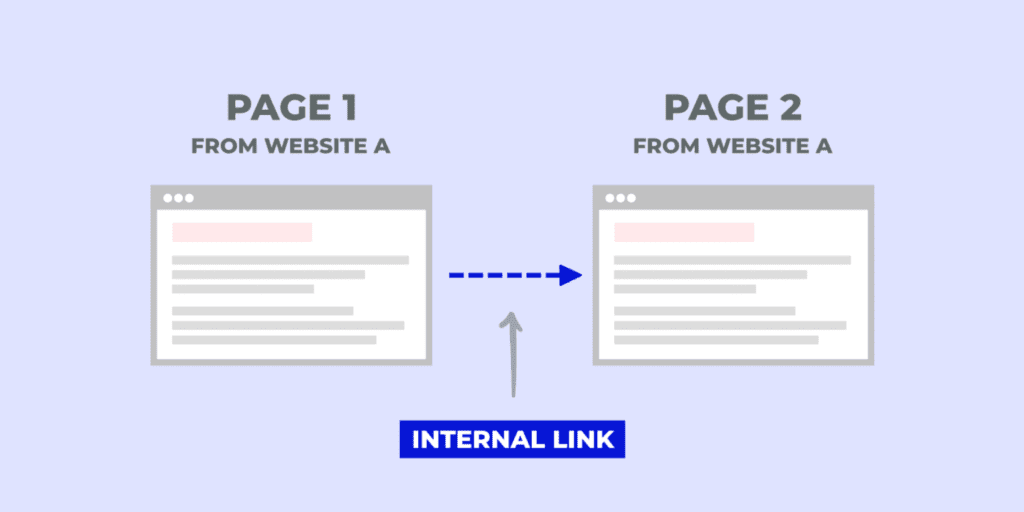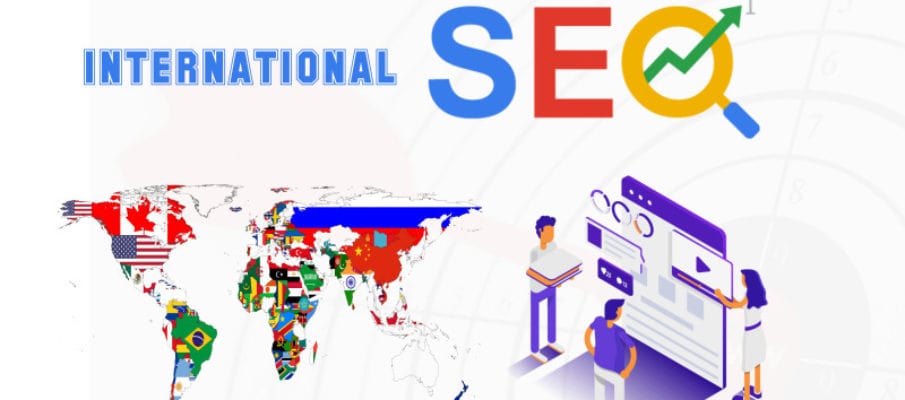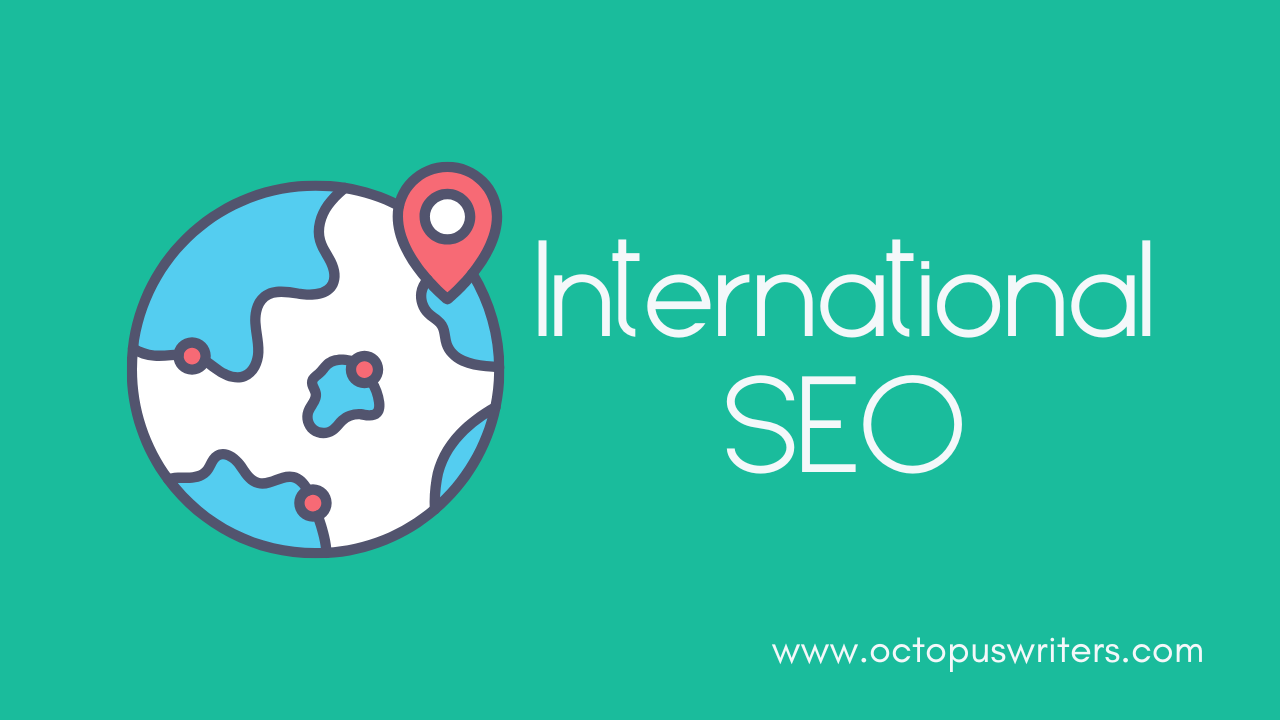In today’s digital landscape, businesses are constantly looking for ways to expand their reach and grow their audience. One powerful strategy that has gained prominence is International SEO. As a comprehensive approach to optimizing your website for global markets, it ensures your content ranks well across different countries and languages.
At OctopusWriters, we specialize in crafting SEO-driven content that not only resonates with diverse audiences but also helps businesses unlock international opportunities. With our expert team, your brand can effectively navigate the complexities of International SEO to stay ahead in a competitive global market.
What is international SEO?
International SEO involves tailoring a website or blog so that search engines understand the specific countries and languages you are targeting for your business.
Essentially, international SEO acts as the geographical version of SEO, where instead of optimizing your site for local or national traffic, you focus on reaching audiences in various countries and languages.

What is international SEO?
In simpler terms, while the phrase “international SEO” might seem complex or unfamiliar, the concept is likely more recognizable than it appears once put into practice.
Do you need to go international?
If a significant portion of your website traffic comes from users in other countries or those who speak different languages, it may be time to adjust your website to provide a better experience for these international visitors.
At first glance, International SEO might seem like a complex or unfamiliar concept, but in practice, it’s likely something you already have some understanding of. Think of it as geotargeting, but instead of focusing on traffic from your local area or country, you’re optimizing your site for various languages and countries.
If your goal is to fully internationalize your website (meaning you’re targeting both a different language and country), there are three key steps to achieving this “international geotargeting”:
- Use a URL structure that clearly indicates the country or region you’re targeting (country-specific targeting).
- Apply language tags to your pages to indicate which language they are optimized for (language-specific targeting).
- Develop and maintain content in the languages of your target audience, as this content is essential for ranking well.
In some cases, you may only need to focus on targeting either a particular language or country. For instance, if you run a T-shirt business that specializes in Spanish-language slogans, you might want to target Spanish speakers without focusing on a specific country, since your products could appeal equally to audiences in Spain and Mexico.
-
What is International SEO for?
Imagine you’re running a successful business in Mexico, both offline and online. Your online presence is thriving, and suddenly, you begin attracting visitors from countries like Colombia, Spain, and Argentina.

What is international SEO for?
This sparks an idea: could your business have strong potential in these regions?
Mexico, Colombia, Argentina—they all share the same language, right?
You might be tempted to think you can simply deliver the same content to all of them and quickly expand into these markets.
Not so fast!
While this approach might seem logical, it’s essential to be cautious. Success isn’t just about ambition; it also requires strategic planning.
What you need now is to optimize your website or blog to effectively reach these diverse audiences.
This is where International SEO comes into play. It helps you configure your website so search engines understand which languages and regions you’re targeting. By doing this correctly, you can ensure your site reaches the countries you want to engage through the web.
However, all of this depends on factors like the nature of your business, your resources, your customers, and the actual needs of your audience.
As you can see, International SEO comes with many considerations, but that’s exactly why it’s important to start planning now and find the strategies that work best for you.
Among all the “it depends” factors, there are a few core principles that remain consistent, and these are worth discussing as you begin your journey toward expansion.
International SEO best practices
URL structures for international sites
Webmasters have several URL structure options to help target specific countries with their websites. These include using a country code top-level domain (ccTLD), subdomains, subdirectories or subfolders, a gTLD with language parameters, or even a completely different domain name. Let’s break down each approach:

URL structures for international sites
ccTLD – According to Google, ccTLDs consist of two-letter codes that signal to both users and search engines the country, sovereign state, or territory where a website is registered. However, it’s worth noting that some country codes, such as .ly for Libya, are so widely used for other purposes that Google now considers them as generic domains.
Language-target your website (or website pages)
You can signal to search engines which languages your website supports by using hreflang or language meta tags—small snippets of code that specify in which language your content is available.
Here are some additional best practices to follow:
- Ensure that everything on your website—from navigation to content and customer support—is in the main language of the region you’re targeting.
- Avoid using machine translations, as they still lack accuracy and quality.
- Don’t automatically redirect users to another language based solely on their location. It’s fine to suggest an alternate language, but don’t assume. A person searching in English from France could be an expat, a language student, or simply browsing in English.
- Refrain from using cookies or scripts to display different-language versions of a page, as search engines can’t crawl dynamic content, and users may also struggle to access it.
Tailor your content to your target user’s language and culture
Ensure that the content you provide is tailored to your target audience. By incorporating the local language, currency, and time zone, along with relevant contact details like addresses and phone numbers, you send a clear message to both users and search engines that your site is relevant to them. Additionally, consider cultural nuances when designing your site and crafting content, as aspects like color schemes, layout preferences, and humor can vary greatly across regions.
By making it obvious that your page is designed for their needs, you enhance the likelihood of a positive user experience.
It’s also important to note that when done correctly, International SEO should be almost invisible to users. Visitors should simply receive the right content in their language and appropriate to their region, without needing to think about it. The real focus is on providing search engines with the necessary signals to present the correct content to the appropriate audience, rather than drawing user attention to the SEO itself.
International targeting in a nutshell
If you’re aiming to target a particular country, consider using a ccTLD. However, if your focus is solely on language rather than geography, a ccTLD may not be the ideal choice, as it’s designed for specific regions rather than languages. In such cases, it’s better to explore other internationalization methods like using hreflang tags, subfolders, or subdomains, either on their own or alongside a ccTLD. If you opt not to use a ccTLD for your international site, you should weigh the pros and cons of using subdirectories versus subdomains as alternatives.
What are the Basic Principles of International SEO?
When we mention principles, we’re referring to key foundational elements that must be treated as essential.
Therefore, if your goal is to connect with new countries via the Internet, here’s what you need to be aware of:
Keywords between regions
Try this exercise: Open an incognito window and search for your country on Google. For instance, if you’re in the United States, go to google.us; if you’re in Chile, use google.cl. Each country has its own dedicated Google domain. Then, pick one of your keywords and search for it across two different Google domains. You’ll often notice that the same content with the same keyword appears in different positions on each domain.

Keywords between regions
Understanding Regional Differences
We also conducted this exercise! To refine our search, we used SEMRush, and here are my findings for the keyword “Search Engines” in Spanish, or “motores de búsqueda.” So, why does this happen? There are many reasons, including keyword traffic, the relevance of keywords in different countries, and regional search behaviors, to name a few. In our example, the search volume for the keyword “Search Engines” in Mexico is higher than in Spain. This highlights the importance of International SEO in understanding how different countries interact with the same keywords.
Localizing Content for Different Regions
It’s possible that in Mexico, the top-ranking page is better optimized for the keyword than my article. In Spain, people might not be specifically searching for “Search Engines,” which explains the lower search volume there. Each region has its own unique language patterns, expressions, vocabulary, and distinct informational needs. This is why content tailored to your local audience won’t always resonate with users in other countries you’re aiming to target.
Language and Search Habits
Consider this: if you can see variations in rankings for a single keyword within the same language, imagine how your ranking would change in other languages. If your business is looking to engage with a second language, it’s important not just to translate the keyword but also to consider how people search for that term. Take Brazil as an example—search behaviors there differ significantly from those in Portugal or Angola, despite everyone speaking the same language. International SEO highlights that search habits will vary across regions, no matter the shared language.
Adapting to Different Search Engines and Devices
Additionally, the device used for searching, whether it’s a computer or a smartphone, can impact how the search is conducted. The search experience also varies depending on the search engine. For instance, searches on Google will differ from those on Bing or Baidu, each with its own unique dynamics.
Tips for Effective Keyword Research
Begin by conducting searches on Google.X for the specific region you’re aiming to target. Use this opportunity to dive deep into how each keyword relevant to your business is being utilized. Pay attention to how it’s handled in the target country. Start by analyzing the top-ranking pages on the first page of search results within your industry, and take note of how they optimize each term.
-
How to Succeed in International SEO?
When approaching international SEO, two key elements must be considered: the Content Marketing strategy and the technical structure of the website or blog.
Content Marketing for international SEO
To begin with, let’s clarify one thing: everything discussed here assumes you are already familiar with Content Marketing and have established your SEO strategy.
If this isn’t the case, we recommend diving into these topics first so you can start your internationalization on the right foot:
- Content Marketing — A comprehensive guide to mastering this essential aspect.
Once you’re ready, let’s explore some key steps to help your business enter international markets successfully.
After setting a clear objective, the first step is to create a map of the countries you want to target, noting the main competitors in those new markets.
If you’ve already completed this, the next phase involves evaluating SEO opportunities in the selected countries.

Content Marketing for international SEO
This means performing searches in their respective SERPs to understand what’s ranking and identifying the SEO factors that will help you boost your digital visibility.
To do this, you’ll need some basic analysis tools like Google Analytics and SEMRush. Don’t forget to open the search engine in an incognito window.
Once you have the necessary information, follow this four-step checklist:
Define Your Target Audience
You likely already have your buyer persona defined in your home country. Now, it’s time to create a new persona tailored to the regions you’re targeting.
Even before securing your first customer, you can define this by using Analytics. Look at the “Public – Geo – Local” or “Languages” section to gauge not just audience trends, but also discover relevant topics and content for new regions.
Alternatively, use SEMRush or similar tools, selecting your destination country and observing which keywords are ranking well.
Always ensure the keywords you’re targeting are truly aligned with your market sector, and evaluate their search volume before proceeding.
Remember the earlier example we gave about the differences in keywords between search engines in Mexico and Spain. That’s why considering search volume is so important!
Finally, use keyword tools to uncover terms that are both relevant and well-positioned.
Analytics will give you insight into your organic performance in each country or language.
Analyze Your Competition
You likely already know who your competition is, but tools like SEMRush can offer further validation.
A key point to remember is that you should focus on organic competition. International SEO is primarily about organic ranking strategies, not SEM.
Understanding your competitors is crucial, as it helps you identify challenges in maintaining a strong online presence in new markets.
Conduct International Keyword Research
Returning to the core principle of international SEO, beyond what we’ve already covered, use tools to compare domains.

Conduct International Keyword Research
Leverage Google’s predictive text or conduct competitive research using tools like SEMRush. Visit competitors’ websites to analyze the topics they cover, the keywords they target, and ensure you’re creating content that is even better.
Create Content
Once you’ve selected your keywords, it’s time to develop content in the local language.
For companies aiming to enter markets that offer the same services, this step is generally straightforward. However, minor content adjustments may be necessary.
For example, in our Spanish blog, we often face the challenge of translating the word ‘Marketing’. In Colombia, it’s called “mercadeo,” while in Mexico, it’s referred to as “mercadotecnia.” Which term should you target if you’re interested in both countries?
We decided to use both terms throughout our content, explaining the two variations and their contexts. This approach allowed us to address both regions effectively.
In some cases, creating separate content for each keyword may be a better strategy, but be cautious not to duplicate content unnecessarily. Analyze the situation carefully to avoid wasting resources.
For businesses not aiming to cater to a new region in the same service category, the language aspect is more critical.
Many opt for translations, which are perfectly valid and permitted by Google—don’t hesitate to use this method.
However, avoid relying on automated translators, as they often produce subpar results. Human translation, especially by native speakers, is always preferable.
Automatic translators can miss the intent behind certain words, fail to translate expressions correctly, and don’t optimize keyword placement.
So, yes, translations are valid! But they require thorough research and careful consideration.
Alternatively, creating original content in the target language is always an option. If you identify a keyword opportunity with a significant audience, original content is highly valued in the new region.
This wraps up the Content Marketing aspect of international SEO.
If you think about it, it’s not much different from the approach you take with your existing marketing strategy, right?
Next, let’s dive into the more technical side of international SEO, which is what truly distinguishes it from traditional SEO.
Decide on the main technical aspects
It’s essential to establish the technical foundation of your international SEO strategy.

Decide on the main technical aspects
This includes everything from selecting the right server location to choosing the optimal site structure and ensuring proper Hreflang implementation.
Website structure
For this step, you must have a clear objective: are you targeting a specific country, language, or a hybrid approach?
If your focus is on multiple countries that speak the same language, a language-based approach is ideal.
However, if you aim to reach a specific country or audience, it’s better to go with country segmentation.
Once you’ve defined this, the next step is choosing the structure that aligns with your goals:
ccTLD (Country Code Top-Level Domain): This involves using a domain that includes the country extension you’re targeting. By doing so, your site is automatically geolocated. For example, a “.com.mx” domain signals that your content is tailored for Mexico. But, if you plan to target more than one country, each domain will need to be handled as a separate project, and each one will start with no SEO authority.
Example: www.exemplo.com.mx
Subdirectories: In this setup, the content is placed within a specific subdirectory under your main domain. This allows your site to inherit some of the root domain’s authority without starting from scratch. You can set up the geographic targeting through Google Search Console.
Example: www.exemplo.com/mx
Subdomains: Subdomains are a good alternative if you don’t want to manage a second-level domain. Google views subdomains as independent sites, much like ccTLDs. Subdomains also need manual geolocation configuration.
Example: www.mx.exemplo.com
gTLD (Generic Top-Level Domain): These are not country-specific, so if you’re using them for content aimed at a specific country, you must configure the geolocation in Google Search Console or Bing.
Parameter: This is a URL modifier used to tag user pathways and alter page content based on those parameters, often to indicate the language of the page.
Hreflang: The hreflang tag is crucial for helping Google understand which version of your site to show based on the user’s language and geographic location. For instance, this tag tells the search engine that the page is in English for US-based users.
Remember the tool we previously discussed to help you decide on your goal? It can also assist you in choosing the best technical structure for your site. Give it another try!
How International SEO Differs From Traditional SEO
Let’s get straight to the point:
International SEO is a lot more intricate than standard SEO.
Sure, the fundamental principles remain the same.
But when it comes to international SEO, things get far more complicated.
With traditional SEO, your focus is relatively simple: you’re optimizing for users in a specific country.
This allows for more straightforward and targeted keyword strategies.
But with international SEO, you’re dealing with multiple regions, each having its own language and set of keywords.
This means your strategy and execution will need to vary significantly.
Let’s break it down:
| Comparison Point | Traditional SEO | International SEO |
| Target Audience | Local area, region, or country-specific | Multiple countries or languages |
| Language | Typically one language, usually the dominant one | May involve variations of the same language or multiple languages |
| Cultural Considerations | Tailored to local preferences | Requires deeper cultural adaptation for various global audiences |
| Domain Structure | One domain, simple structure | Use of ccTLDs, subdomains, or subdirectories for different countries or languages |
| Keyword Strategy | Local keywords specific to a region/country | Different keyword research for each country or language |
| Search Engine Focus | Usually Google or the dominant local search engine | Must optimize for multiple search engines (e.g., Baidu, Yandex) |
| Technical SEO | Standard practices like mobile-friendliness and site speed | Additional aspects like hreflang tags, canonical URLs, and JavaScript for language switchers |
| Legal Compliance | Adheres to local laws | Must comply with regulations in various countries |
| Content Strategy | Geared towards local interests and events | Localized content that is culturally relevant across different regions |
As you can see, International SEO means handling numerous elements simultaneously.
You’ll need to work with various keyword sets, each customized to the language and region.
And the technical side? It’s a whole other challenge:
- Different content pages for each region
- Correct implementation of hreflang tags
- Managing canonical tags
- Handling JavaScript for language switchers
- Setting up a database to deal with multiple currencies
And this is just scratching the surface.
Cultural differences also play a huge role.
When entering a new region, there are nuances and preferences that are harder to grasp than technical details like hreflang tags.
It’s clear that international SEO is not an easy task.
Does International SEO Make Sense for Your Business?
What are your long-term business goals?
We’re not talking about your immediate objectives over the next six months.
Consider where you see your business in the next 3-5 years.
Why ask this question?
Because diving into international SEO will likely involve:
- Partnering with local marketing agencies
- Developing content tailored to each specific market
- Running targeted advertising campaigns
All of these steps will require a solid, on-the-ground presence sooner rather than later.
In other words, it’s a significant commitment.
So, if this feels overwhelming, international SEO may not be the right move for your business at this point.
The Benefits of International SEO for Global Businesses
Investing in international SEO enables businesses to expand their online visibility and connect with varied audiences when entering new markets.
Now, let’s dive deeper into these two key advantages:
Increased Visibility on a Global Scale
Optimizing your content for various regions helps search engines understand its relevance to users in those areas, increasing the likelihood of appearing in local search results.
For instance, a fashion brand based in the U.S. could conduct targeted keyword research for their new market in the U.K. (we’ll cover more on this shortly) to uncover popular search terms.

Increased Visibility on a Global Scale
Imagine the brand identifies keywords like “UK clothing brands” and “fashion stores in London.” The U.S. company could then:
- Create localized product descriptions using these keywords and U.K. terminology (e.g., using “trousers” instead of “pants”)
- Incorporate these region-specific keywords into content, URLs, metadata, and more
- Build backlinks from well-established U.K. websites
By implementing these strategies, the brand could boost its rankings in U.K.-focused search results and attract more relevant visitors, increasing the chances of converting them into customers.
Expanded Customer Base
International SEO gives you the opportunity to broaden your brand’s reach and engage with new audiences across the globe.
If your competitors haven’t yet ventured into those markets, you’ll be in a prime position to gain an edge in every new region you target where they haven’t established a presence.
You can quickly assess whether a major competitor is focusing on the same market by using tools like Keyword Overview. Just enter their domain and set the database to the country you are targeting.
By reviewing the “Positions” report, you can discover which keywords they are ranking for in that particular market. The more regions you can cover and the more relevant searches you can appear in front of, the higher your chances of converting those users into paying customers.
How to Create an Effective International SEO Strategy
Expanding internationally requires a well-thought-out strategy to effectively connect with and engage global audiences.
Here’s a breakdown of the essential steps to create a successful international SEO strategy:
Conduct Thorough Market Research for Different Regions
To tailor your International SEO efforts to your new audience, it’s essential to conduct in-depth market research for the region you’re targeting. This includes analyzing your competitors to understand their approach to SEO in the specific market.
You can leverage tools like Semrush’s Market Explorer to identify local competitors, gather audience insights, and discover valuable keyword opportunities.

Conduct Thorough Market Research for Different Regions
Here’s how you can get started:
Open the tool and go to the “Find Competitors” section to begin your research.
Enter the target location and your domain, then click “Research a market” to begin.
The Market Explorer tool will present a detailed dashboard offering insights into your new market.
In the “Overview” tab, you’ll find information about the major competitors, top keywords, regional traffic distribution, and more. This will provide a clear view of your new competitive landscape.
Next, explore the “Audience” tab to gain insights into your target audience’s demographics. You’ll find details on age, socioeconomic status, interests, social media habits, the websites they visit, and more—critical data for optimizing your International SEO strategy.
Identify Target Keywords for International Optimization
Now, it’s time to uncover the keywords that your target audience uses to search for topics related to your business.
Your keyword research should account for language differences, cultural contexts, and specific search patterns in international markets.
By analyzing your competitors’ keywords, you can identify valuable opportunities and pinpoint the queries that are driving traffic and conversions for them.
To begin, use the Keyword Gap tool. This will allow you to compare your current rankings with those of your competitors in the new market you’re targeting, helping refine your International SEO approach.
Adapt Your Content for Cultural and Regional Preferences
When crafting content for specific regions, it’s essential to reflect the unique values, communication preferences, and cultural expectations of your target audience. This goes beyond simple translation — it’s about true content localization.
While translation merely shifts words from one language to another, maintaining their literal meaning, localization takes a broader approach. It adapts content to meet the specific cultural, regional, and contextual needs of the audience, ensuring it resonates more deeply with them.

Adapt Your Content for Cultural and Regional Preferences
Localized content can enhance user engagement because it feels more familiar and relevant. Additionally, it fosters a positive perception of your brand in the new market.
For effective localization, consider integrating links to authoritative websites within the region and using examples that align with local traditions or practices. Visual elements like colors, images, and symbols should also be chosen based on what appeals to your audience, keeping in mind their cultural norms and preferences.
Other factors to consider include:
- Local sizing and fit preferences
- Date format differences (MM-DD-YYYY in the U.S. vs. DD-MM-YYYY in Europe)
- Seasonal variations (e.g., summer in the U.S. is winter in Australia)
- Local currency and pricing strategies
- Compliance with local regulations, such as the General Data Protection Regulation (GDPR) in the EU.
By keeping these aspects in mind, you can better align your International SEO strategy with local expectations and increase the effectiveness of your global outreach.
Build Relevant Links
Securing backlinks from reputable websites in your target market can significantly enhance your website’s ranking and drive targeted traffic to your localized pages.
To successfully earn these backlinks, your content must be aligned with the interests and needs of the local audience. Simply translating content isn’t enough if the visuals, data, and messaging don’t resonate with the region’s unique context.
For instance, if you have an infographic that highlights hiring trends in the U.S., translating it into Spanish without adapting the content to local context won’t be valuable for an audience in Spain. Incorporating relevant regional data and local visuals is crucial for making your content appealing to local sites that may link back to it.
Content format also plays a critical role in attracting backlinks. Certain types of content are more likely to be referenced and shared, including:
- Comprehensive guides that establish your expertise
- Original research and data
- Step-by-step tutorials and how-to guides
- Infographics and visual representations of data
- Case studies and client success stories
- Interactive content such as quizzes and calculators
To find suitable backlink opportunities and perform outreach, you can use tools like the Link Building Tool. By incorporating these strategies into your International SEO efforts, you can strengthen your website’s authority and visibility in new markets.
Technical Considerations for International SEO
Focusing on technical SEO is essential for ensuring that search engines can effectively crawl and index your international content. This can significantly boost your website’s rankings and visibility in the regions you’re targeting.
Implement Region-Specific URLs
A localized URL structure is key to signaling to both users and search engines that your content is tailored for a specific region or audience.

Implement Region-Specific URLs
Google suggests a few strategies for setting up region-specific URLs:
- Country-specific domain: This option clearly differentiates websites for each country and is ideal when server location isn’t a concern. However, it can be costly and restricts targeting to a single country. For example: www.yourwebsite.de.
- Subdomain with a generic top-level domain (gTLD): This method is easy to set up and works well if your website is hosted across multiple locations. The downside is that it may not immediately convey whether the site is country-specific or language-specific. For instance: www.fr.yourwebsite.com.
- Subdirectory with a gTLD: Subdirectories are simple to implement and maintain, as they rely on the same hosting. However, they can make it harder to differentiate between regions, as the location may not be obvious from the URL. Example: www.yourwebsite.com/fr/.
Choosing the right URL structure is an important aspect of international SEO, as it helps both users and search engines recognize your region-specific content.
Implement Hreflang Tags
Hreflang tags are HTML attributes used to indicate the language and regional focus of webpages on a multi-language or multi-regional website.
These tags play a crucial role in international SEO.
Why are they so important?
Hreflang tags tell search engines which version of a webpage is the most appropriate based on the user’s language and location.
In essence, they help search engines display the correct language version of a webpage to users in a specific market, ensuring that users are shown the most relevant content. This method is more reliable than other SEO strategies when targeting different regions.
Handle Duplicate Content and Canonicalization Issues
Duplicate content occurs when identical or very similar content appears in several locations on your website, which is often a concern when utilizing international SEO.
This can lead to a problem known as keyword cannibalization, where different pages compete with each other, potentially lowering their ability to rank effectively.

Handle Duplicate Content and Canonicalization Issues
To avoid or resolve duplication issues, canonical tags are a useful tool.
These HTML attributes identify the preferred or “canonical” version of a webpage. Essentially, they inform Google which version of a page should be considered the primary one, helping prevent confusion and improving SEO performance.
Optimize Website Speed and Performance
Page speed plays a vital role in delivering a seamless user experience on your website. Slow-loading pages can increase bounce rates and negatively affect your search rankings.
You can assess the speed of specific pages with Google’s PageSpeed Insights tool. To enhance your website’s speed for a global audience, consider the following optimizations:
- Utilize a Content Delivery Network (CDN) to distribute your content across multiple global servers.
- Compress images and other files to decrease page load times.
- Ensure your site is optimized for mobile devices.
- Implement effective caching strategies to store static versions of your web pages, making them quicker to serve to visitors.
Regularly Audit Your Website to Uncover Any Technical SEO Issues
Semrush’s Site Audit tool is a valuable resource for identifying technical SEO issues by crawling every page of your website. It can pinpoint problems like missing H1 tags, incorrect pages in your sitemap, duplicate title tags, and issues with hreflang tag implementation.
To get started, simply enter your website’s domain and click on “Start Audit.”
From there, you can customize the crawl settings, including the number of pages to check and the source for the crawl. Once ready, select “Start Site Audit.”
The “Overview” dashboard provides an overview of your website’s health, showing key metrics.
For hreflang implementation issues, head to the “Errors” tab, where potential problems will be displayed.
Click “Why and how to fix it” to get more details on each issue and advice on how to resolve it. This audit process is essential for ensuring that your international SEO strategy is running smoothly.
Measure and Analyze International SEO Performance
Tracking and analyzing the performance of your international SEO strategy is vital for determining what’s effective and what needs adjustment.
Before diving into the data, it’s essential to clarify your success metrics. What specific goals are you targeting in each market you’re working to reach?
Next, ensure you have the right tools in place, like Google Analytics 4 (GA4), to help monitor and evaluate user activity across different regions. GA4 provides reports that allow you to dig into key analytics, ranging from general insights to more detailed metrics.
Key reports to track international SEO performance include:
- Traffic Acquisition Report: Find this under “Life cycle” in the “Reports” tab, then click “Acquisition” and select “Traffic acquisition.” This report shows how much organic traffic is coming from different regions, user engagement levels, and more.
- Landing Page Report: Access this from the “Reports” tab under “Engagement,” then “Landing page.” Here, you can identify which pages are the main entry points for visitors to your site.
In addition to these reports, you can use the Position Tracking tool to monitor keyword rankings for each region.
To get started, enter your domain, click “Set up tracking,” and then select your preferred search engine, device type, and target location. Afterward, click “Continue To Keywords,” and add the relevant keywords for your international markets. You can also upload a file with your keyword list if you already have one.
Once you’ve finished setting it up, click “Start Tracking.”
The Position Tracking dashboard will give you an overview of how the keywords are ranking in different regions, helping you assess the success of your international SEO efforts.
For convenience, you can set up email notifications to receive ranking updates or create custom alerts for specific keyword performance insights. This makes it easier to stay informed about your international SEO performance without manually checking rankings.
Unleash Your Global Potential with International SEO
Expanding into new markets can significantly increase your sales, but first, you need to enhance your visibility in those regions by adopting international SEO best practices and consistently tracking your progress.
Are you prepared to go global?
Start with Semrush for free to explore tools that can assist you in identifying region-specific keywords, conducting thorough market research, and much more.
10 International SEO Best Practices + Checklist
International SEO involves optimizing your website to attract users from different countries and speak various languages. The primary objective is to increase traffic from a global audience by tailoring your website’s content, structure, and strategy to meet regional and linguistic differences.

10 International SEO Best Practices + Checklist
Define your international markets
You likely have some ideas about which global markets you want to target, based on factors beyond SEO, such as your operational capabilities in certain countries.
However, it’s also important to examine SEO metrics to identify markets that offer the most potential for your business. Your company might:
- Naturally plan to enter this market in the near future.
- Be missing out on a high-demand foreign market.
- Overlook a low-competition market that could be lucrative.
To get an initial sense of where there’s search potential, you can enter your competitors into Ahrefs’ Site Explorer and review the graph showing their estimated organic traffic share by country. This can give you insights into markets with promising SEO opportunities.
Consider all languages spoken in each global market
If your international SEO approach involves countries where multiple languages are spoken, you might need to offer content in various languages for each region.
For instance, in Canada, both French and English are official languages, according to Wikipedia. To effectively target this market, you would need to create both a French-Canadian and an English-Canadian version of your content, ensuring you reach users who speak either language.
Decide on your URL structure
When setting up your URL structure for international sites, careful planning is crucial. It will dictate where the content for each global SEO market is located on your website. There are three primary options to choose from, each with its own advantages and challenges, as well as one method you should avoid entirely.

Decide on your URL structure
Install a content delivery network (CDN)
A slow website experience for users in international markets can negatively affect your global SEO performance. If you’ve chosen a ccTLD or subfolder structure for your site and matched it with localized hosting, your content is more likely to load quickly for users in those regions.
However, if your international website serves multiple countries, it’s essential to consider using a Content Delivery Network (CDN) to optimize speed.
A CDN distributes your website content across a network of servers globally, allowing users to access the content from the server nearest to them. This reduces page load times and enhances the overall user experience across all regions, making it an important factor for international SEO.
Conduct keyword research for each of your international markets.
Once you’ve established your technical SEO foundation, the next step is to conduct international keyword research and tailor your global SEO strategy to suit each target market. This is essential, even if you’re only launching your international efforts in one language.
As mentioned earlier, terminology can differ significantly across countries, even when the language is the same. This variation directly impacts the keywords that your potential customers are likely to search for, making localized keyword research crucial for a successful international SEO campaign.
Use one language per page
Once you’ve set up your international website’s URL structure and completed keyword research for different regions, you’ll be ready to develop a content strategy tailored for each foreign SEO market.
It’s crucial to ensure that each page targets only one language. For every piece of content, create a separate web page for each language you want to optimize for.
Localization should be applied wherever possible. This includes not only your on-page text and meta information but also elements such as:
- Images
- Currencies
- Time zones
- Phone numbers (if applicable)
- Office addresses (if applicable)
Avoid using dynamic translation tools on the same URL. Google advises creating dedicated URLs for each language and region. This allows search engine crawlers to properly discover, understand, and index the different versions of your content.
If you’re taking a more targeted approach, segmenting your site by country rather than just language, it’s also a good practice to create country-specific page versions. This enhances both user experience and international SEO efforts.
Ensure internal links only go to content in the same language
A common mistake when expanding internationally is linking internally to the wrong version of your content. This not only leads users to pages in a different language but can also confuse search engines like Google by sending mixed signals.
To avoid this, ensure that your internal links always point to content targeting the same country or language as the page where the link is placed.

Ensure internal links only go to content in the same language
Best practices for internal linking in international SEO: If your international website has only a few pages for a particular country or market, it might be a sign that you’re not ready to fully launch in that region. A limited number of pages will restrict your international SEO performance and traffic, and can negatively impact user experience if there’s insufficient relevant content.
Launching with a more comprehensive set of pages will help Google associate your brand and website more effectively with the target market. As a general guideline, ensure you have enough localized content to support key internal links, especially in areas like header and footer navigation, when implementing a new international SEO strategy.
Implement hreflang properly
Hreflang is a type of code typically placed in the backend of a webpage (or sometimes via sitemaps). It functions as a mapping system, helping Google identify the different URL versions of a specific page.
This is crucial for Google to understand:
- The target market of the current page.
- Alternative page versions for users in other regions.
- A default version to display for users searching from markets without a specific page (optional).
By implementing hreflang, you can improve user experience and also boost your international SEO rankings by allowing Google to recognize closely related duplicate pages, particularly those in the same language.
While hreflang doesn’t directly pass PageRank, Google will prioritize the most authoritative version of a page based on the user’s search language. When users conduct a search, Google will then display the most appropriate version for their location.
Hreflang implementation can get quite complicated, but don’t worry—our expert Joshua Hardwick has put together an easy-to-follow beginner’s guide on hreflang.
To check for potential hreflang issues, Ahrefs’ Site Audit tool (free with an Ahrefs Webmaster Tools account) is an excellent resource. Start by running an SEO audit on your site, and then navigate to the Localization report to identify any errors or issues with your hreflang tags.
Don’t redirect users based on their IP address or cookies
Instead of automatically redirecting users to the wrong version of your site, it’s better to give them the option to manually switch to the correct version.
Avoid redirecting users based on their IP address or cookies. This not only frustrates visitors but also complicates the experience for search engine bots.
Google, in particular, often crawls websites from a US-based IP address. Therefore, using IP-based redirection could unintentionally block Google from accessing non-US content on your site. Furthermore, bypassing the redirect for Googlebot isn’t recommended either. Google should have the same access to content as your human users.
Google itself advises against using IP-based redirections:
“These redirections may block both users and search engines from viewing all the versions of your site.”
Additionally, Google’s documentation expands on this by stating:
“Don’t rely on IP analysis to customize your content. It’s often inaccurate, and Google may not be able to properly crawl different versions of your site. Most Google crawls originate from the US, and Google doesn’t attempt to vary its location to detect site differences.”
Instead of IP-based redirection, you could consider offering users an option to switch their site version manually. Apple, for example, uses a simple prompt allowing users to select the correct location or language.
Providing a clear navigation menu that lets users switch between different languages or regions is a great alternative. This method can enhance user experience and could even improve conversion rates by making it easier for visitors to find the right version of your site.
Build your backlink profile in each of your target countries
Even if you have a strong presence in your domestic market, establishing authority in new international markets is essential.
For example, a backlink from a reputable site in the U.S. might not carry the same influence in Mexico.
Many businesses overlook this aspect, but it’s a crucial part of any international SEO strategy, despite being covered later in this guide.
To evaluate the state of your backlinks in different regions, use Ahrefs’ Site Explorer. Go to the “Overview” section and select the “Backlink profile” tab.
Checking backlinks in Ahrefs’ Site Explorer
Scroll down to see a world map highlighting the sources of your backlinks. You can also apply the “Country-code only” filter to view links from ccTLD domains.
Backlink analysis by top-level domain in Ahrefs
Regularly monitoring this report helps identify areas where your link-building strategy in certain markets may need more attention. You can also analyze your competitors’ backlink reports to discover where their international link-building successes are coming from.
Why international SEO is important for global business
If your competitors aren’t optimizing their content for specific countries or languages, this presents an opportunity for you to fill that gap. By localizing your content for those regions, you can drive more traffic and gain a significant competitive advantage. Now, let’s explore the key benefits of implementing international SEO for businesses eyeing global expansion.

Why international SEO is important for global business
Reach a wider audience
Given the global reach of the internet, businesses have a tremendous opportunity to connect with a wide and varied audience. By adopting international SEO techniques, companies can effectively target specific regions and languages, helping them engage with potential customers worldwide. This broader reach can result in higher traffic, greater brand visibility, and increased sales across different markets.
Increase organic traffic, conversions, and revenue
Ranking for relevant keywords in various languages and regions can greatly enhance a website’s organic traffic. Properly executed international SEO attracts users who are searching for products or services in their own languages and locations. This focused strategy often results in higher conversion rates, driving increased revenue and supporting business expansion.
Improve global brand visibility
Establishing a strong digital presence across different countries and regions boosts brand visibility and authority worldwide. When users frequently see a brand appearing in search results in their native language, it builds trust and reinforces the brand’s credibility. Positive user experiences and strong brand recognition not only cultivate loyalty but also encourage referrals, further solidifying the brand’s position in the global marketplace.
With these advantages in mind, developing a tailored international SEO strategy is a valuable investment.
Subdomain vs. subfolder: What to choose for international SEO?
The key challenge in international SEO is how to set up dedicated versions of your website to optimise for global search. Two of the most popular approaches for this are:
- Subdomain
- Subfolder
Let’s explore the advantages and disadvantages of each.

Subdomain vs. subfolder: What to choose for international SEO?
Subdomain
A subdomain is essentially a division of your main domain, functioning as an independent site. For example, consider this format:
subdomain.example.com
While not the most popular choice for international SEO, subdomains are treated by search engines as separate entities from the main domain. This means each subdomain requires its own crawling and indexing, and the link equity from the primary domain does not transfer as effectively to subdomains compared to subfolders.
However, subdomains do come with specific advantages. They allow you to fully customise each subdomain, essentially treating it as an entirely separate website. Additionally, hosting subdomains locally can enhance page load speeds, which can help with local SEO.
Advantages:
- High level of customisation and control
- Simple to manage
Disadvantages:
- Lower link equity passed from the main domain
- Requires individual crawling and indexing
- Higher maintenance costs
Subfolder
A subfolder (also known as a subdirectory) is a folder that resides within your main domain. For instance, here’s an example of how it looks:
example.com/international-seo
The subfolder approach is the most commonly used strategy for international SEO. It is cost-effective and simplifies management since all content resides under the same domain, allowing you to easily create landing pages for different regions.
However, subfolders come with some limitations in terms of customisation. When using content management systems (CMS) like WordPress, you may encounter restrictions, often resulting in the use of a single template for all markets, which can limit both creativity and functionality.
Advantages:
- Affordable and easy to manage
- Domain authority is shared across subfolders, helping with SEO rankings
- Requires less maintenance
- Easier to track through reporting tools
Disadvantages:
- Limited customisation and flexibility
- SEO management can become complex for large websites, especially when ensuring that crawlers correctly treat subdirectories as localized versions.
Expand your reach with international SEO
Enhancing your website with international SEO is crucial for broadening your global presence. By gaining insights into the unique characteristics of your target markets and applying tailored international SEO techniques, you can reach a wider audience, increase traffic, and drive higher conversion rates.
Customizing user experiences to align with cultural and language differences, while continually monitoring and refining your performance, will ensure the ongoing success of your international SEO efforts. With an effective International SEO strategy, your business will be better positioned to seize global opportunities.
International SEO – Frequently Asked Questions

International SEO – Frequently Asked Questions
What’s the difference between ccTLDs, subdomains, and subdirectories for International SEO?
ccTLDs (country-code Top-Level Domains): These are domain extensions specific to a particular country, such as .co.uk (United Kingdom), .de (Germany), or .jp (Japan). They can help target specific geographic regions more effectively.
Subdomains: These are additional domains attached to your main domain, separated by a period. For example, if your main domain is example.com, a subdomain could be [invalid URL removed] or [invalid URL removed]. Subdomains can be used to organize different parts of your website or target specific regions.
Subdirectories: These are folders within your main domain, separated by a forward slash. For example, [invalid URL removed] would be a subdirectory targeting English-speaking audiences. Subdirectories are often used to create different language or regional versions of your website.
Choosing the right approach depends on several factors:
- Target audience: If your target audience is primarily in a specific country, a ccTLD might be the best option.
- Language: If you need to create different language versions of your website, subdirectories or subdomains can be used.
- Brand recognition: If your brand is well-known, you might consider using subdomains to maintain a consistent brand identity across different regions.
What tools can help with International SEO?
Google Search Console: This free tool provides insights into how your website performs in Google Search. It can help you identify issues with your international SEO, such as duplicate content or indexing problems.
Google Analytics: This tool tracks website traffic and user behavior, allowing you to measure the effectiveness of your international SEO efforts.
Ahrefs: This paid tool offers a suite of SEO tools, including backlink analysis, keyword research, and competitor analysis.
SEMrush: Another paid tool that provides similar features to Ahrefs, including keyword research, competitor analysis, and site audits.
What are common challenges with International SEO?
Language barriers: Ensuring your content is accurately translated and culturally relevant can be challenging.
Geo-targeting: Targeting the right regions and understanding local preferences can be difficult.
Currency and payment options: Offering appropriate payment options and currency conversions can be important for international customers.
Legal and regulatory compliance: Adhering to different laws and regulations in various countries can be complex.
Technical issues: Ensuring your website is optimized for different languages and regions, including proper URL structure and hreflang tags, can be technical.
How can I track the performance of my international SEO efforts?
Use Google Analytics: Track key metrics such as traffic, conversions, and user behavior.
Monitor search engine rankings: Use tools like Google Search Console to track your website’s rankings for relevant keywords in different countries.
Analyze keyword performance: Identify which keywords are driving traffic and conversions in different regions.
Track conversions: Measure the effectiveness of your international SEO efforts by tracking conversions, such as sales or sign-ups.
Conduct A/B testing: Experiment with different approaches, such as language versions or content, to determine what works best.
Conclusion
In conclusion, mastering International SEO is essential for businesses looking to expand their global reach and connect with audiences across different markets. By understanding the intricacies of hreflang tags, domain structures, and local optimization, companies can significantly improve their visibility and rankings on a global scale. At OctopusWriters, we specialize in crafting tailored International SEO strategies that cater to your specific business goals, ensuring that your website ranks effectively across different regions and languages. Let us help you navigate the complexities of International SEO and drive your global success. Reach out to OctopusWriters today and take the first step towards enhancing your international online presence!

